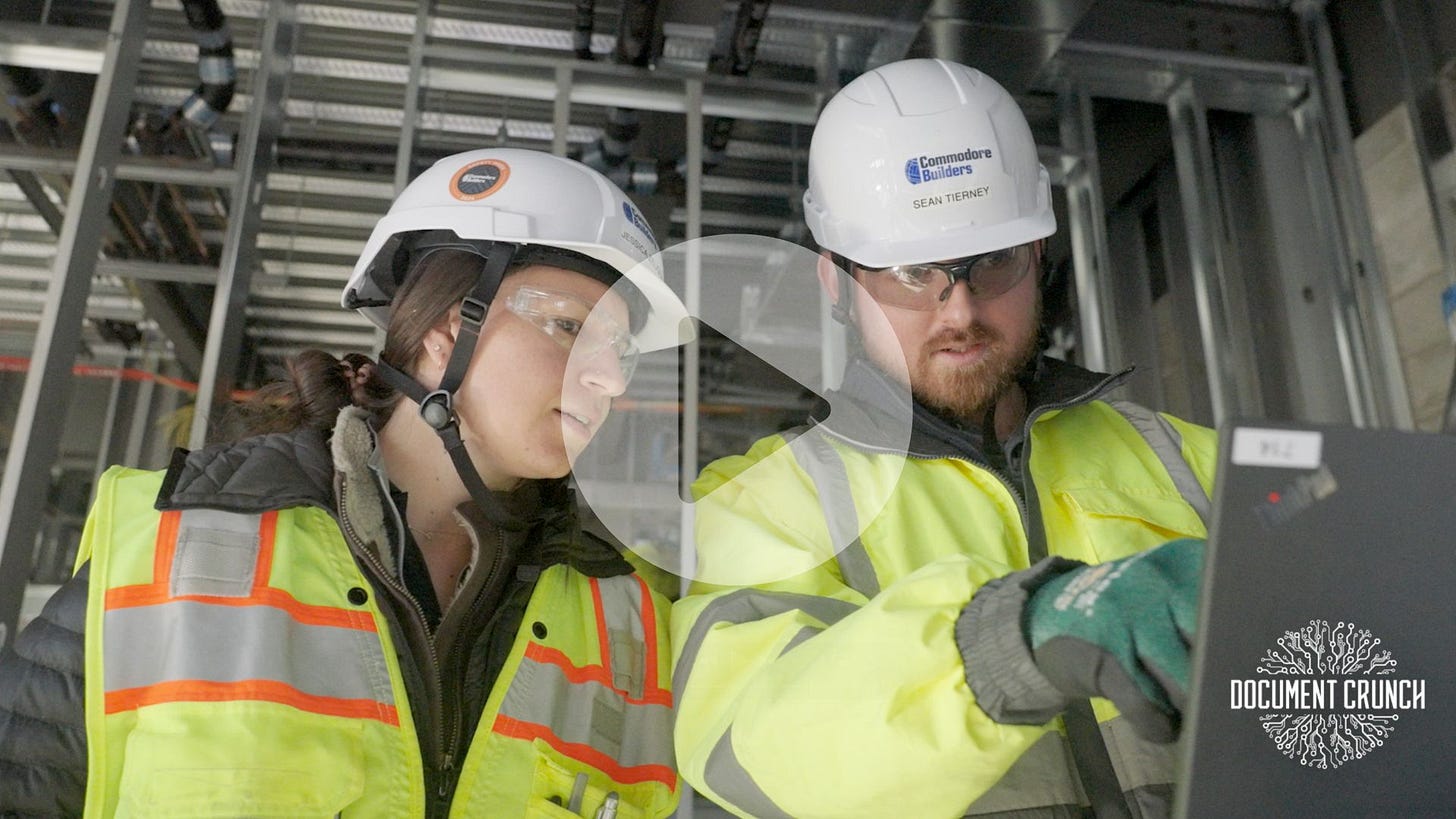Do You Really Understand Your Contract?
Why contract compliance is foundational to achieving better project outcomes.
👋 Hey, Kyle here! Welcome to The Influential Project Manager, a weekly newsletter covering the essentials of successful project leadership.
Today’s Overview:
The construction industry is known for its complex and lengthy contracts that are long, complex, and hard to understand. They can create confusion and put your project at risk.
In the $13T global construction industry, an estimated 50% of projects finish late or over budget. That means someone will end up paying more than they originally planned. Will it be you?
Today’s article introduces a simple 5-step system to manage contracts like an attorney and protect your project.
🏗️ Today’s issue is brought to you by Document Crunch!
Why Commodore Builders Trusts Document Crunch to Keep Projects on Track:
At Commodore Builders, efficiency and precision are the foundation of every project, but their project teams faced a common construction challenge: balancing hands-on fieldwork with the time-consuming task of quickly finding accurate information within their contracts and project documents. Document Crunch provided the AI-powered solution they needed.
See how the Commodore team uses Document Crunch to keep critical information organized and instantly accessible. By centralizing project data, the document compliance platform helps them:
Manage projects more effectively
Avoid unexpected issues and delays
Ensure all work aligns with contract requirements
Commodore now kicks off every project with Document Crunch, resulting in smoother operations and better project outcomes. Watch how Document Crunch has become an essential part of Commodore Builders' project success here.
💼 Do You Really Understand Your Contract?
Filed under: Project Management
Contracts are the glue that bind every construction project together.
They define expectations, allocate risks, and outline responsibilities. But too often, project leaders treat them as mere paperwork—until a missed clause or misunderstood obligation turns them into an expensive lesson in risk and liability.
I’ve seen it firsthand: one overlooked detail can crush a project. The question isn’t if challenges will arise—it’s when. Will you be prepared?
This week, we’re introducing a high-leverage system to help you think like an attorney, keeping you and your team protected, proactive, and in control.
Why Project Managers Must Think Like Attorneys
“Risk comes from not knowing what you're doing.” - Warren Buffett
In the $13T global construction industry, an estimated 50% of projects finish late or over budget. That means one or more stakeholders will end up paying more than they originally planned. Who will pay? The answer lies in your contracts and how they’re managed.
The construction industry is known for its long, complex contracts filled with legal jargon. This often leaves project leaders—especially those without deep legal expertise—confused and exposed to significant risks that can affect project success.
If you don’t master your contracts, they can become your biggest liability. This where The Attorney archetype comes in: rather than hoping legal issues will never arise, you must plan ahead, build the right behaviors, ask the right questions, and make sure contracts work in your favor.
The Three Pillars of The Attorney
Attorneys don’t win cases by guessing—they follow a system. To take control of your outcomes, understand the three pillars:
Risk Intelligence: Understanding what’s beneath the surface of your contract documents.
Negotiating: The ability to secure terms that protect your interests.
Compliance: The actions that integrate contract requirements into daily decisions and workflows.
These pillars form a progressive framework. First, identify risks. Then, negotiate protections; and finally, embed compliance into your team’s daily workflow.
Mastering these pillars creates an antifragile project management system—one that not only survives risk but thrives by navigating it effectively.
The 5-Step System for Contract Compliance
Once your contract is negotiated and signed, it becomes your project’s guiding document.
However, most teams lack a full understanding of their contracts, which only leads to profit losses, delays, and strained relationships. It’s time to make contract compliance your competitive advantage with these five steps:
1. Identify risks prior to bidding the job.
Effective risk management means being able to identify all the risk exposures and build an effective plan to either mitigate or manage them.
What to do:
Scrutinize the contract thoroughly before pursuing a project.
Differentiate between controllable and uncontrollable risks—know what you can mitigate and what requires contingency planning.
Perform a gap analysis to highlight deal breakers, missing provisions, and unfavorable terms.
Leverage AI tools to compare terms against industry best practices.
Action Step: Conduct a pre-bid contract risk assessment on every project and document everything. Identify deal-breakers before committing resources.
2. Negotiate risks and terms to your standards.
A well-negotiated contract isn’t about winning every clause—it’s about clarity, fairness, and risk distribution.
What to do:
Define a clear scope and responsibilities; avoid vague terms that invite disputes.
Allocate risks appropriately so liabilities match your capabilities.
Validate that the final terms reflect what was negotiated.
Action Step: Before signing, hold a team-wide contract review to ensure no hidden risks slip through the cracks.
3. Educate the project team on how to comply.
A contract is useless if your team doesn’t understand it. Begin every project kickoff by educating teams on critical obligations.
What to do:
Distill key contract terms by summarizing the prime agreement, Division 1 specs, and risk areas.
Educate your project team on their critical contractual obligations during kickoff meetings
Action Step: Create a one-page contract summary that is clear and simple enough for everyone to understand.
4. Embed daily decision support in project workflows.
Every project faces risks—you can cover them, absorb them, or remove them. Instead of hoping risks disappear, equip your team to handle them in real time.
What to do:
Provide real-time access to contract insights via a digital playbook.
Integrate the key contract terms into your daily workflows to ensure decisions align with obligations.
Maintain and review a risk register weekly, with team members reporting on risks and discussing solutions.
Use the playbook during staff meetings, the RFI process, change management sessions, and schedule updates.
Action Step: Implement a quick-reference system for on-site decision making and sync it with your project management tools.
5. Automated compliance for daily workflows and obligations.
Manual compliance checks can’t keep up with project pace. Thanks to AI, we can ensure contracts are followed before problems arise.
What to do:
Use AI-driven tools to monitor contract compliance automatically.
Set smart notifications to alert you before deadlines or required actions are missed.
Turn contracts into strategic assets by using automation to refine future contract strategies and outcomes.
Action Step: Integrate automated contract management tools to consistently track and address compliance issues.
🔥 Your One-Week Jump Start
Ready to take control of your contracts? Start this week:
Audit: Review your current contracts for red flags and pinpoint any terms that don’t align with your risk tolerance.
Summarize: Create a one-page summary of key contract points for your team—leave out the legalese!
Reference: Set up a quick-reference system for your on-site decisions.
Automate: Start integrating AI-powered compliance tools to flag deviations automatically.
The goal isn’t perfection—it’s antifragility. By getting ahead of risk and owning your contracts, you empower your team to lead with confidence.
Until next week,
Kyle Nitchen

Whenever you're ready, there are 5 ways I can help you:
Get my first book! No Bullsh*t Project: A Project Manager’s Guide to Successful Project Leadership
Upgrade your scheduling software. Experience the future planning system for construction and real estate development. iPM subscribers get a 15% discount on the first year license.
Get my full toolbox (free). Access 30+ software and hardware tools I'm using today.
Learn Takt Planning. Elevate your skills as a scheduler, planner, and lean builder with the Takt Planning & Control online course. Use code "Influentialpmtakt" for 30% off.
Advertise in my newsletter. Put your brand in front of 6,000+ construction project managers, leaders, and execs. (Booked out 8 weeks)





Imagine being a contract expert without going to law school. That's what Document Crunch does for PMs
@kyle, Most people are super excited when they sign the contract and fail to take the time to follow advice like what you proposed. But when things "get sticky," it will be worth the effort.